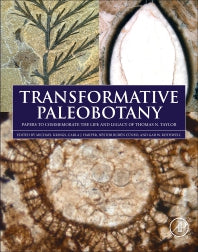Freshly Printed - allow 10 days lead
Couldn't load pickup availability
Transformative Paleobotany
Papers to Commemorate the Life and Legacy of Thomas N. Taylor
Authoritative compendium of current hypotheses in paleobotany that includes major interpretations of conceptual and evolutionary ideas
Michael Krings (Edited by), Carla J. Harper (Edited by), N. Ruben Cuneo (Edited by), Gar W. Rothwell (Edited by)
9780128130124, Elsevier Science
Hardback, published 13 September 2018
732 pages
27.6 x 21.5 x 3.8 cm, 2.22 kg
Transformative Paleobotany: Papers to Commemorate the Life and Legacy of Thomas N. Taylor features the broadest possible spectrum of topics analyzing the structure, function and evolution of fossil plants, microorganisms, and organismal interactions in fossil ecosystems (e.g., plant paleobiography, paleoecology, early evolution of land plants, fossil fungi and microbial interactions with plants, systematics and phylogeny of major plant and fungal lineages, biostratigraphy, evolution of organismal interactions, ultrastructure, Antarctic paleobotany). The book includes the latest research from top scientists who have made transformative contributions.
Sections are richly illustrated, well concepted, and characterize and summarize the most up-to-date understanding of this respective and important field of study.
EARLY LAND PLANTS: INNOVATIONS AND ADAPTATIONS 1. The evolutionary origin of the plant spore in relation to the antithetic origin of the plant sporophyte 2. Early Devonian woody plants and implications for the early evolution of vascular cambia 3. Using architecture modeling of the Devonian tree Pseudosporochnus to compute its biomass 4. The advantages and frustrations of a plant Lagerstätte as illustrated by a new taxon from the Lower Devonian of the Welsh Borderland, UK 5. Early Tracheophyte Phylogeny: A Preliminary Assessment of Homologies
LATE PALEOZOIC AND MESOZOIC PLANTS AND FLORAS 6. Lower Permian flora of the Sanzenbacher Ranch, Clay County, Texas 7. Permian ginkgophytes of Angaraland 8. Glossopterid plant remains in permineralization: What do they tell us? 9. Pachytestopsis tayloriorum gen. et sp. nov., an anatomically preserved glossopterid seed from the Lopingian of Queensland, Australia 10. A Triassic Mystery Solved: Fertile Pekinopteris from the Triassic of North Carolina, U.S.A. 11. Enigmatic, structurally preserved stems from the Triassic of central Europe: A fern or not a fern?
PALEOBIOGEOGRAPHY, BIOLOGY, AND PHYLOGENETIC RELATIONSHIPS OF PLANTS 12. A comprehensive assessment of the fossil record of liverworts in amber 13. Aerodynamics of Fossil Pollen: Implications for Understanding Pollination Biology in Extinct Plants 14. Escapia gen. nov.: Morphological evolution, paleogeographic diversification, and the environmental distribution of marattialean ferns through time 15. Heterosporous ferns from Patagonia: The case of Azolla 16. Why are bryophytes so rare in the fossil record? A spotlight on taphonomy and fossil preservation 17. Fossil seeds with affinities to Austrobaileyales and Nymphaeales from the Early Cretaceous (early to middle Albian) of Virginia and Maryland, U.S.A: new evidence for extensive extinction near the base of the angiosperm tree
FOSSIL MICROORGANISMS 18. Reactive Oxygen Defense Against Cellular Endoparasites and the Origin of Eukaryotes 19. Fossils of arbuscular mycorrhizal fungi give insights into the history of a successful partnership with plants 20. Looking for arbuscular mycorrhizal fungi (AMF) in the fossil record – an illustrated guide 21. Exceptional preservation of sessile, long-stalked microorganisms in the Lower Devonian Windyfield chert (Scotland) 22. Morphological convergence in forest microfungi provides a proxy for Paleogene forest structure 23. Ediacarans, protolichens, and lichen-derived Penicillium: A critical reassessment of the evolution of lichenization in fungi
ANTARCTIC PALEOBOTANY 24. Polar Regions of the Mesozoic–Paleogene greenhouse world as refugia for relict plant groups 25. Leaf venation density and calculated physiological characteristics of fossil leaves from the Permian of Gondwana 26. Functional significance of cambial development in Vertebraria roots: How do unusual xylem traits serve life at a high latitude? 27. Cretaceous to Paleogene vegetation transition in Antarctica
Subject Areas: Botany & plant sciences [PST]


